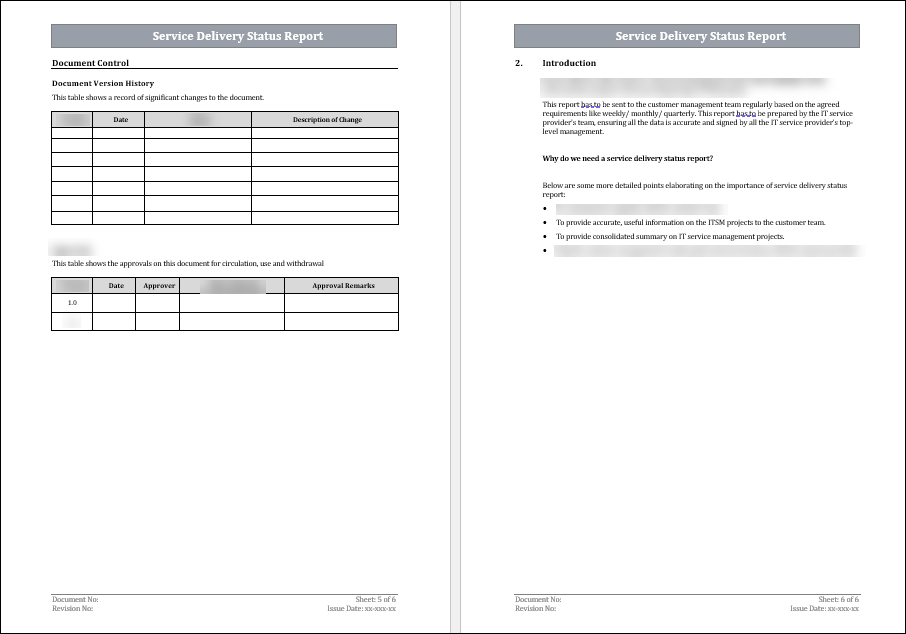Service Delivery Status Report Template
Introduction
A Service Delivery Status Report Template in IT Governance is a structured document that provides a thorough assessment of the present state and performance of an organization's IT services. This template often contains critical information such as project summaries, service performance indicators, highlighted issues and obstacles, action items and resolutions, and future milestones and objectives. Using this template, organisations can improve visibility into their IT service delivery processes, improve stakeholder communication, and enable informed decision-making.

Importance Of Service Delivery Status Report
Service Delivery Status Reports are critical components of IT governance because they provide a real-time snapshot of an organization's IT service performance and health. These reports provide insight into ongoing initiatives, critical performance metrics, and potential difficulties, allowing stakeholders to make more informed decisions. In an era where technology is crucial to corporate operations, these reports are an important communication tool, encouraging team collaboration and ensuring that all stakeholders have a common knowledge of project status, milestones, and strategic objectives.
Roles And Responsibilities Involved In Service Delivery Status Report
1. Service Delivery Managers:
- Responsibility: General accountability for the successful delivery of services.
- Role In The Status Report: Provide high-level insights regarding service delivery performance, major milestones, and issues. Ensure that the report is in line with the strategic objectives.
2. Project Managers and Team Leaders:
- Responsibilities: Managing specific projects or teams contributing to service delivery.
- Role In The Status Report: Provide detailed project status updates, including progress, risks, and resource requirements. Highlight any concerns that could affect service delivery timelines.
3. Data Analysts and Reporting Specialists:
- Responsibility: Analyse and assemble pertinent data for the report.
- Role In The Status Report: Collect, process, and analyse data on service delivery indicators. Ensure that the information contained in the report is accurate and full.
4. Technical Support Teams:
- Responsibility: Ensure that the technical parts of service delivery run smoothly.
- Role In The Status Report: Provide information on system performance, outages, and resolutions. Highlight any technical issues that may impact service delivery.
5. Customer Support Representatives:
- Responsibility: Respond to client inquiries, issues, and feedback regarding service delivery.
- Role In The Status Report: Share your observations from consumer contacts, including typical problems and feedback. Provide feedback on client satisfaction and suggestions for improvement.

Best Practices for Effective Service Delivery Reporting
Here are best practices for creating and managing service delivery reports:
- Clearly Define Objectives and Audience: Clearly explain the objectives of your service delivery reports and identify the intended audience. Customise the content and amount of detail to match the needs and interests of various stakeholders, making sure that the information is relevant and beneficial to each group.
- Establish Key Performance Indicators (KPIs): Define and measure key performance indicators (KPIs) that are compatible with organisational goals. These indicators could include service uptime, response times, incident resolution rates, and customer satisfaction ratings. KPIs offer a quantifiable assessment of service performance.
- Ensure Timely And Regular Reporting: Establish a regular reporting schedule that is consistent with the needs of stakeholders. Timely reporting ensures that decision-makers have current information to make informed decisions. Consistency in reporting timelines fosters a sense of dependability and predictability.
- Use Visuals For Clarity: Use visual components like charts and graphs to communicate data in a clear and intelligible manner. Visuals can help stakeholders understand trends, patterns, and variations in service delivery performance.
- Include Trend Analysis: Beyond displaying basic statistics, include trend analysis. Identifying patterns and trends across time allows stakeholders to better understand the trajectory of service delivery performance and anticipate future difficulties or opportunities.
Conclusion
As technology continues to play a critical part in corporate operations, the importance of this reporting method cannot be stressed. The Service Delivery Status Report is a valuable tool for decision-makers, stakeholders, and teams because it provides a real-time overview of ongoing projects, key performance indicators, difficulties, and resolutions.

